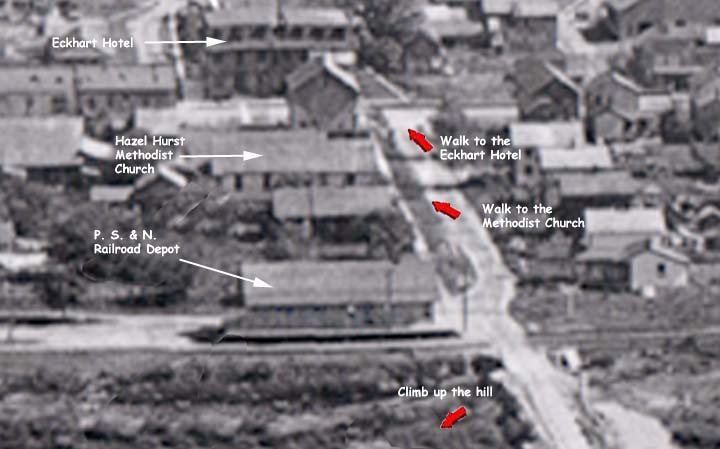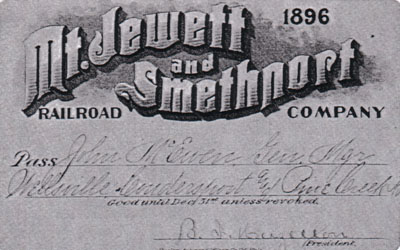
Read story below
Go back to the Chemical Works

Mike Arthurs collection


| This is a railroad pass for the Mt. Jewett and Smethport Railroad signed by B.F. Hazelton. |

Mike Arthurs collection
|
|
|
The first railroad in Hazel Hurst came about as a result of the sawmills established there by Benjamin F. Hazelton. Hazelton was born in Machias, Cataragus County, New York on March 26, 1857. He was married to Clarissa Purple. He was first involved in timber cutting and sawmill operations in Hazelton Mills, approximately six miles west of Bradford, Pennsylvania, from about 1883 until 1890. In 1889, another sawmill was constructed and operated in Glen Hazel, Pennsylvania, for about two years. On September 2, 1891, Hazelton purchased a 58 acre tract of land along the flats adjacent to Marvin Creek, Hamlin Township, in Warrant 2607. This land was owned by George Richards and his wife, Cora (Housler). This property was originally purchased by Lyman B. Fletcher on September 20, 1869 from the McKean and Elk Land and Improvement Company and sold to George Richards on May 23,1884. In 1892, Hazelton constructed two mills along the flats adjacent to Marvin Creek - one a hardwood mill in early 1892 and a bark hemlock mill completed one year later. Hazelton's main customer was the Hoyt Brothers tanneries. William, Oliver and Mark Hoyt of New York city purchased approximately 3,500 acres of timberland, part of which was in the woodland surrounding Hazel Hurst. The bark mill was located one mile south west of the hardwood mill at a place called Point Pleasant and later known as Shingle Town. Hazelton did not personally manage the mill operations but entrusted the management of the daily operations to Edwin F. Clark. Mack Healy was contracted for getting the out of the woods to the mills. The sawmill operated a new type of band saw that was designed and manufactured by the Clark Brothers Company of Belmont, New York. This saw represented the leading technology of its day and set numerous sawing records. Hazelton liked to name his sawmill sites after himself and after Hazelton Mills and Glen Hazel, it was not surprising that his newest sawmill site was named Hazel Hurst. The town of Hazel Hurst (originally spelled Hazelhurst) came into being in the fall of 1892. In order to transport the lumber products out of Hazel Hurst to the eastern markets, Hazelton petitioned and obtained charter approval for the Mt. Jewett and Smethport Railroad on May 23, 1892. The capital stock was $150,000 of which $52,875 was paid into the company. Labor cost for construction of the railroad was $43,547 and the material and equipment cost was $10,299. In 1894, there were 70 employees whose total pay for the year was $6,381. In the same year, the railroad carried 1,349 passengers who paid a total far of $13,199. Total freight for that year was 53,479 tons for which the railroad was paid $12,165. The officers and directors were Benjamin F. Hazelton (President), A.L. Hazelton (Vice-President), Frank P. Hazelton (Secretary) and Edwin E. Tate, J.L. Brown and Edwin F. Clark (Treasurers). A standard gauge railroad was constructed over 5.1 miles from Mt. Jewett to Hazel Hurst by way of two contiguous switch backs from the western end of the Marvin Creek valley to the eastern end of Mt. Jewett where it joined with the Erie Railroad and the Buffalo, Rochester and Pittsburgh railroad. Connections with the Mt. Jewett, Kinzua and Riterville railroad was also possible. The switch backs were necessary because of the elevation differences between Mt. Jewett (2195 feet) and Hazel Hurst (1716 feet). In addition to the switch backs, there were also four short trestles having a combined total length of 105 feet. The railroad crossed current US Route 6 in front of the Clark Douglas homestead in Mt. Jewett which is currently the American Legion and Veterans of Foreign Wars posts. In 1895, the line was extended 2.6 miles to Marvindale (previously named Gallup) to reach the chemical works there. The Mt. Jewett and Smethport name was misnomer because this railroad did not extend to Smethport from Mt. Jeweet until later as the Pittsburgh, Shawmut and Northern Railroad. B.F. Hazelton was the owner of two Shay locomotives built by the Lima Locomotive works in Lima, Ohio. The first Shay (Shop Number 231) was completed on February 1, 1889. This Shay was first used at the Hazelton Mills Location. In 1892, Hazelton transferred the train to the Hazel Hurst mills. This Shay was in service with various lumber companies in McKean county and was finally used for the Day Chemical Company operations on the Valley Railroad in Westline, Pennsylvania, beginning in 1901. While at the Hazel Hurst mills, he acquired a second Shay (Shop Number 395) that was completed on the July 29, 1892 and was used until the mills shut down in 1899. This locomotive was used by several other companies and was eventually scrapped in 1920. The Shay was a standard gauge train. These locomotives were well suited for carrying heavy loads and operating on steep grades that could not be used by other locomotives. They could operate well on rough and uneven track. Each wheel was a drive wheel providing excellent overall traction. The boilers had large volume steam spaces to allow operation on steep grades. Overall the Shay was nearly ideal for it's ability to operate on steep grades, sharp curves and light, uneven rails while carrying heavy loads. The railroad line also carried passengers in a single car at the end of the lumber cars. The passenger stops along the route where at Mt. Jewett, Enterprize, Hazel Hurst and Marvindale. The train rank daily except Sundays. There was a railroad station in Hazel Hurst adjacent to and directly across Marvin Creek from the Hazelton sawmill and lumberyard. At Point Pleasant, up Marvin Creek from Hazel Hurst, there was a train stop and water tower. This was primarily a log loading point with log slides coming down off the hill on both sides of the valley. There was also a shingle mill located here. The dinky railroad was built to haul logs from south of the town to the hardwood mill in town. The track began near the mill and crossed main street at Cleveland Avenue to the end of Champers Street. It went up the steep grade above the town's water reservoir and switch backed toward the upper end of Orchard Row and then south curving near the top of the grade near the Katherine swamp. It continued past a spring and logging camp known as Patsy's Camp. It continued south around the hill and joined the Pennsylvania Railroad at, Quinwood, west of Clermont. Hazelton died in May of 1898 and the lumber mills went on for only a short time after that. Hirem Palmer operated the mill for about a year and they were closed in 1899. The demise of the lumber industry led to the end of the Mt. Jewett and Smethport Railroad. On August 1, 1899, under the control of John Byrne, the railroad became part of the Pittsburgh, Shawmut and Northern Railroad. The tracks from Hazel Hurst to Mt. Jewett were removed in 1907-1908. The tracks from Marvindale were extended to Smethport, allowing the transport of raw material and finished window and bottle glass from the glass plants that were being built in Hazel Hurst. If not for the introduction of these glass plants, Hazel Hurst would have become a ghost town after only a few years of prosperity. These plants gave the town and the Pittsburgh, Shawmut and Northern Railroad a new lease on life for the next 30 years. Five glass companies located at three separate locations continued to manufacture glass until 1929. High grade silica rock was available at four locations convenient to the plants. The Pittsburgh, Shawmut and Northern Railroad was vital to the glass industry for the entire period of it's existence. It also provided freight services for the G.W. Berkalew and F.J. Bayless Chemical Works (later named the Hazel Hurst Chemical Works), three glass factory locations and the John D Westcott handle factory). The Berney Bond glass plant closed on December 18, 1929. The tracks from Hazel Hurst to Marvindale were removed in 1947. The railroad grade is still easily followed for it's entire distance from Hazel Hurst to Smethport. Story credit: Mike Arthurs collection |